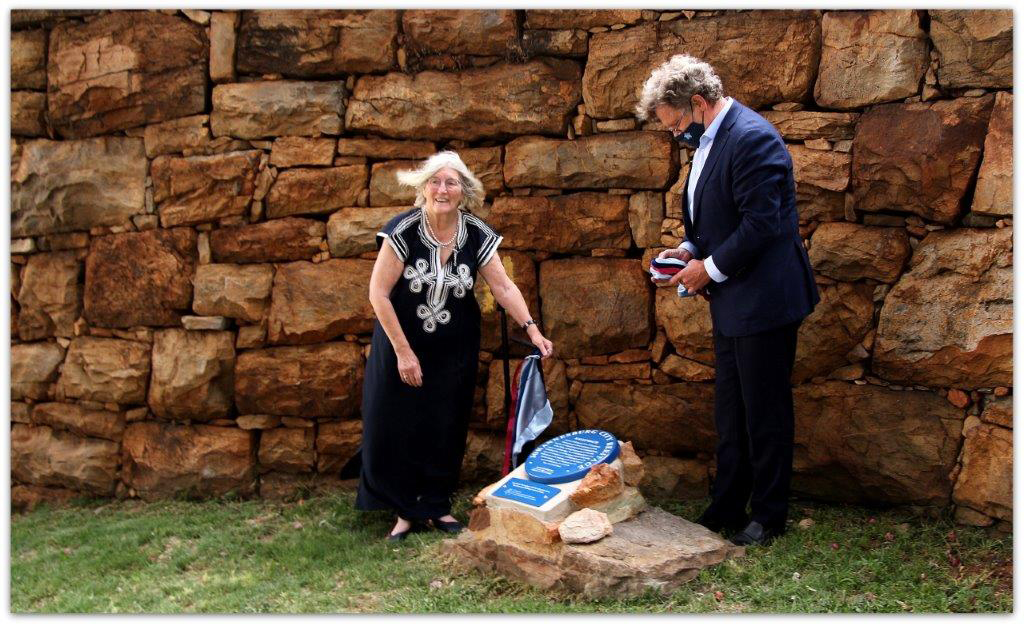click to dowload our latest edition
CLICK HERE TO SUBSCRIBE TO OUR NEWSLETTER


Published
2 years agoon
He was an architect, a developer, a sportsman, a philanthropist, a Zionist, and supporter of the Indian resistance movement (Satyagraha), but Hermann Kallenbach is best known for his close friendship with Mohandas (Mahatma) Gandhi during his time in South Africa.
Now, two new Johannesburg Heritage Blue Plaques have been erected – on Linksfield Ridge and in Mountain View – to honour this extraordinary Jewish Joburg pioneer.
The plaques, unveiled on 17 November, were sponsored by the Lithuanian Embassy in South Africa as a part of a project to honour prominent “Litvaks” who contributed to South Africa. The year 2021 is the 150th birthday of Kallenbach, who was born in Žemaičių Naumiestis in 1871. The Lithuanian government declared 2020 as the year of Lithuanian Jewish history, making the celebration of Kallenbach’s legacy especially appropriate.
Lithuania has also sponsored further research into Kallenbach’s life. Kathy Munro, the chairperson of the Heritage Association of South Africa and the blue plaque committee of the Johannesburg Heritage Foundation, is partnering with Dr Shimon Lev in Israel to “bring Kallenbach out from the shadows of the Gandhi dominance”.
“It was Kallenbach’s karma to befriend Gandhi, but it was both his good fortune and perhaps his misfortune that this should have been the intense and best known relationship of his life,” Munro wrote in her review of Alkis Doucakis’s book, In the Footsteps of Gandhi An illustrated history of Johannesburg’s Linksfield Ridge and environs.
“His significance lay in his success as an architect between 1896 and 1912, and again from 1921 to 1945. His friendship and sponsorship of Gandhi was a special relationship, but my argument is that it did considerable damage to his reputation and work as a fine architect,” Munro said.
As well as being a successful property developer, including of Linksfield and Linksfield Ridge, and donating the land for Sylvia Pass in the 1930s, Kallenbach is known for designing some well-regarded period buildings ranging from churches to synagogues, office blocks to retirement estates. As a philanthroper, he is famous for funding the creation of Gandhi’s communal living experiments in Phoenix, KwaZulu-Natal, for Tolstoy Farm (near Lenasia), and for donating the bulk of his estate to Keren Hayesod for the formation of Israel.
“Kallenbach is an interesting figure, far removed in outlook and temperament from the mainstream of South African Jewry of the time,” said Kallenbach’s grand-niece, Isa Sarid. “He not only adopted Gandhi’s ascetism, but proposed fresh austerities.” It was Gandhi who urged that Kallenbach devote his resources to saving his own people, the Jews, after the Holocaust.
The blue plaques were erected at “The Tents” at 8 Grove Road, Mountain View, and at Kallenbach Drive on Linksfield Ridge.
Kallenbach bought “The Tents” in 1909, named for the bell tent that he and Gandhi camped in on the hillside before he built a thatched stone rondavel, which is still there today. In 1913, “The Tents” was a gathering point for Satyagrahis during the third Indian civil rights campaign, led by Gandhi.
The steep, winding Kallenbach Drive was cut through Linksfield Ridge as a part of Kallenbach’s development of Linksfield Ridge in the 1930s. The plaque was placed on the dry stone retaining wall which Kallenbach – a skilled stonemason – built with the help of African workers. Kallenbach also built stone steps in numerous places along Kallenbach Drive, which provide access to the mountainside properties at the top of the ridge in New Mountain Road.
Kallenbach’s imprint on the ridge isn’t limited to construction. He established a vegetable garden and an orchard on the slopes of Mountain View, and many of the magnificent trees on the ridge today were planted by him, including the huge Jacarandas in the gardens of Nos 5 and 7 New Mountain Road, and a great pepper tree at 8 Grove Road, so symbolic of the pre automobile age when transport to Orange Grove from the city was by horse and buggy down Orange Grove Hill.
Kallenbach died in 1945 in the house he built at No 5 New Mountain Road, and his ashes were interred in a stone crypt on the property of No 4 New Mountain Road – which still exists today – before being taken by his relatives to be interred at Kibbutz Degania in Israel.
Though he didn’t marry and had no children, he was close to his siblings. The plaque unveiling was attended by numerous members of the extended Kallenbach family, including Michael Kallenbach (great nephew), Jacqui Friedlander (great niece), Ronnie Silberman (cousin), and Charles Kallenbach (cousin).
